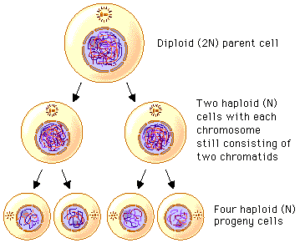Question
The diagram shows part of a genetic diagram for the inheritance of sex in humans.

▶️Answer/Explanation
B
In humans, the inheritance of sex is determined by the presence of sex chromosomes. Females typically have two X chromosomes (XX), and males have one X and one Y chromosome (XY). The sex chromosome carried by the mother (P gamete) determines the sex of the offspring.
- The father produces two types of gametes: one carrying an X chromosome and the other carrying a Y chromosome.
- The mother produces two types of gametes: one carrying an X chromosome (X gamete) and the other carrying a hypothetical P chromosome (P gamete).
- When the father’s Y-carrying gamete fertilizes the mother’s X-carrying gamete, it results in an XY combination, leading to a male offspring.
- When the father’s X-carrying gamete fertilizes the mother’s X-carrying gamete, it results in an XX combination, leading to a female offspring.
In this scenario, the sex chromosome in the P gamete of the mother and the male offspring is X. The male offspring receives the X chromosome from the mother’s P gamete and the Y chromosome from the father, resulting in the XY combination characteristic of males.
Question
Which statement describes human cells formed by meiosis?
A They are genetically identical and they become gametes.
B They are genetically identical and they become tissues.
C They are not genetically identical and they become gametes.
D They are not genetically identical and they become tissues.
▶️Answer/Explanation
C
The correct answer is C: They are not genetically identical and they become gametes.
Meiosis is the process of cell division that occurs in sexually reproducing organisms to produce gametes (sperm and egg cells). During meiosis, genetic recombination and crossing-over events take place, leading to genetic diversity in the resulting gametes. This means that the cells formed by meiosis (gametes) are not genetically identical to the parent cell and carry a unique combination of genetic material.
Question
How does a haploid nucleus differ from a diploid nucleus of the same species?
A It has different genes.
B It has fewer chromosomes.
C It has more alleles.
D It is the result of fertilisation.
▶️Answer/Explanation
B
The correct answer is B: It has fewer chromosomes.
A haploid nucleus contains only one set of chromosomes, whereas a diploid nucleus contains two sets of chromosomes. In a diploid nucleus, one set of chromosomes is inherited from the organism’s mother, and the other set is inherited from the organism’s father. This is why humans, for example, have a diploid number of 46 chromosomes (23 pairs), with 23 chromosomes inherited from each parent.
On the other hand, a haploid nucleus is typically found in specialized cells called gametes (sperm and egg cells in animals, and pollen and ovule cells in plants). These cells are produced through a process called meiosis, which halves the chromosome number, resulting in cells with only one set of chromosomes. This reduction in chromosome number is important for sexual reproduction because when the haploid sperm fertilizes the haploid egg, the resulting zygote will have the full diploid complement of chromosomes, which is necessary for the proper development of the organism.
Question
What results from meiosis of a diploid cell?
A genetically different diploid cells
B genetically different haploid cells
C genetically identical diploid cells
D genetically identical haploid cells
▶️Answer/Explanation
B. Genetically different haploid cells
Meiosis is a type of cell division that occurs in sexually reproducing organisms. It results in the formation of genetically different haploid cells, which have half the number of chromosomes as the original diploid cell. This process is essential for generating genetic diversity among offspring.

Question
Cells are formed by the division of existing cells. Four different cells are shown.
Which cell is produced by meiosis?

▶️Answer/Explanation
A
Cells are formed by the division of existing cells” refers to the fundamental concept that new cells are generated through the process of cell division. There are two main types of cell division: mitosis and meiosis.
Meiosis is a type of cell division that occurs in sexually reproducing organisms to produce gametes (sperm and eggs). During meiosis, the number of chromosomes is reduced by half, resulting in haploid cells (cells with half the usual number of chromosomes). Sperm cells are produced through meiosis in males, and they are haploid cells containing half the normal number of chromosomes, allowing them to combine with an egg during fertilization to form a diploid zygote.
